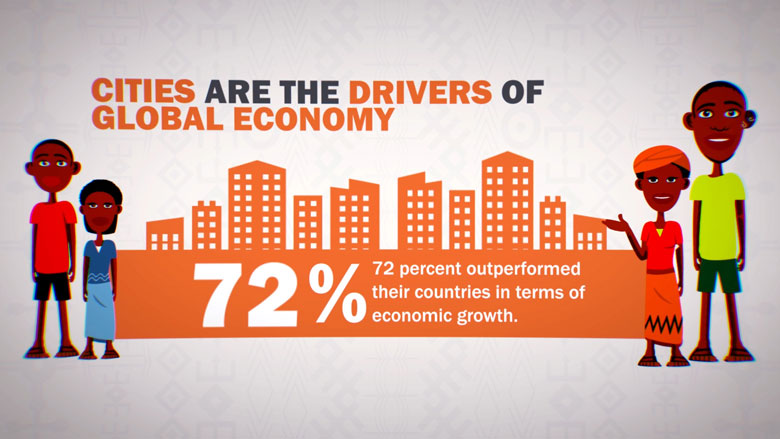The rise of cities can play a key part in creating jobs for the millions of youth who enter the work force every year. Nowhere is this more relevant than in East Asia, where cities have grown faster than anywhere else in the world. Between 2000 and 2010, nearly 200 million people moved to East Asia's urban centers. This includes eight “megacities” with populations over 10 million, and 123 large cities with one to 10 million people.
And with only 36 percent of its total population living in urban areas, East Asia will likely witness many more decades of rapid urban growth. This is simultaneously a great opportunity and challenge. Very few countries have reached income levels of $10,000 per capita before reaching about 60 percent urbanization. If managed well, urbanization, can boost economic growth, help eliminate extreme poverty and boost shared prosperity.
This will, however, need proactive policies to provide land, housing, and services for the new urban residents, and urban planning that matches physical expansion with access to jobs, affordable housing and shopping, high quality public transportation, and health and education services to ensure equal opportunity for disadvantaged communities.
In East Asia, Singapore stands as a good example of sustainable urban planning and urbanization-driven growth, where infrastructure investments were transformed into productive assets for economic expansion and increased prosperity in the city-state, enabling GDP growth to average 7.7 percent in the last 50 years.
Indeed, East Asian economic growth is built by cities, centered on the emergence of dominant economic regions, built on agglomeration economies, like the Mekong Delta and the Greater Bangkok Metropolitan Area. The Pearl River Delta in China is an economic powerhouse and the world’s largest urban area in both size and population, with more inhabitants than countries such as Argentina, Australia, or Canada. These mega regions are the aggregation of many local economic development stories, such as the hard disk drive industry in Northern Malaysia and the clustering of the animation industry around Shanghai and Wuxi.
When our teams conducted research to quantify this phenomenon – the findings of which are in a new World Bank report entitled Competitive Cities for Jobs and Growth: What, Who, and How – they found that globally, 72 percent of cities grow their GDP faster than their national economies.
The report indicates that cities offer a promising route to alleviating some of the world’s vexing problems: poverty and unemployment. But the pathway to growth is not automatic. While many cities offer higher incomes and productivity, many others are poles for poverty, inequality, inefficiency, congestion, and frustration.
How can more cities in Asia do better at generating jobs? How can more cities host dynamic and fast-growing industries?
Our research on 750 cities worldwide found several illuminating patterns.
First, job creation and economic growth are more likely to come from some industries than others – namely those that are tradable. ‘Tradable’ means goods and services that are geographically mobile and, thus, subject to regional and international trade. We found that industries like light manufacturing, food processing, or tourism tend to drive growth in incomes more than non-tradable goods and services like restaurants or household services.
Second, the right combination of policies and investments can set the stage for thriving industries. In the world’s most competitive cities, governments provide a conducive regulatory environment and provide targeted support to particular industries. Effective policy often involves making bets to find winning industries, but also providing a good foundation of a business environment and basic infrastructure for all firms.
Third, mayors and city leaders – and governments more broadly – cannot do it alone. Only close partnership with private sector firms and industries will generate more jobs.
Globally, approximately 75 percent of jobs come from the private sector. It is then no surprise that effective public policies and investments should be coordinated with the private stakeholders in economic development whom they are designed to assist. While it has become common for governments to claim most policies stem from ‘consultation’ with firms and households, the world’s most competitive cities go several steps beyond and exhibit a true coalition between governments and firms. In order to avoid the risk of policy distortions and capture by special interests, governments must also bring a solid fact base of data to their partnerships in order to ensure they are still getting a good deal for their constituents.
Fourth, we noted that a key difference between competitive cities and ‘the rest’ was not the existence of a city development strategy on paper, but effective implementation of strategic actions. Competitive cities align their budgets to finance priority initiatives, rather than letting last year’s spending dictate this year’s budget allocations. Competitive cities proactively solve problems during implementation. Competitive cities mobilize sufficient staff capacity and attention to improve the quality of public initiatives.
Indeed, competitive cities make for more competitive nations. City leaders can be in the driving seat to attain the twin, often elusive, goals of job creation and shared prosperity.
Anabel Gonzalez, Senior Director for the Trade & Competitiveness Global Practice, World Bank
Ede Jorge Ijjasz-Vasquez, Senior Director for the Social, Urban, Rural & Resilience Global Practice, World Bank

